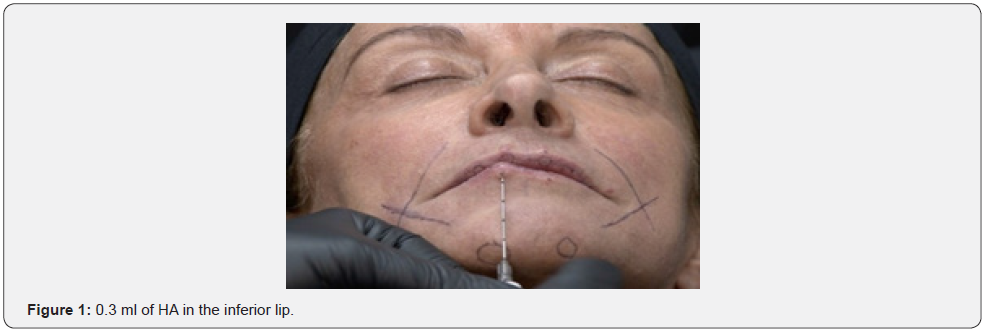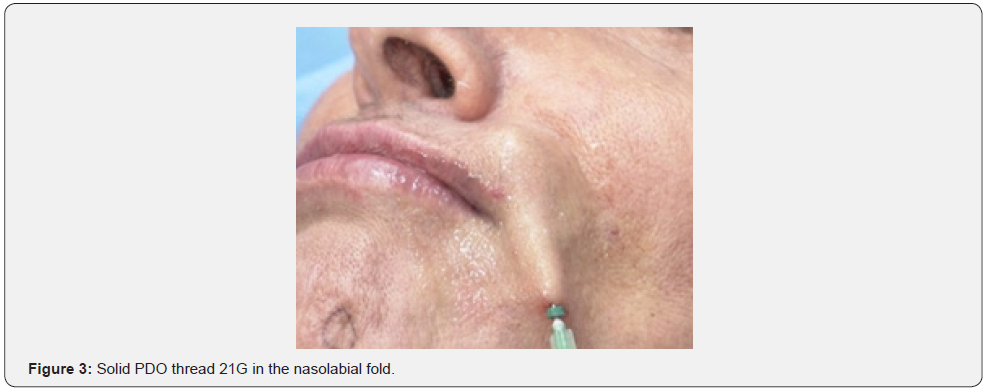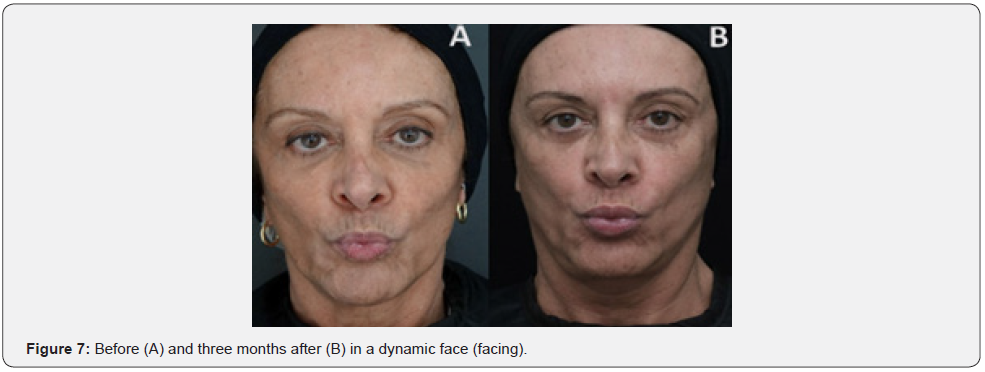Oral Region Myomodulation and Skin Rejuvenation With Polydioxanone Threads and Hyaluronic Acid Filler: Cross-Filler Technique
Eliandre Palermo1, Andrea Fogaça2, Carolina Destefani3, Laura Palermo4 and Maria Claudia Almeida Issa5*
1Department of Dermatologist, Private Office, Brazil
2Department of Dermatology, MSc student at Fluminense Federal Univerisity, Brazil
3Department of Dermatology, Anhembi Morumbi University, Brazil
4Department of Dermatology, Fluminense Federal University, Brazil
Submission: February 27, 2023;Published: March 23, 2023
*Corresponding author: Maria Claudia Almeida Issa, Department of Dermatology, Fluminense Federal University, Brazil
How to cite this article: Eliandre Palermo, Andrea Fogaça, Carolina Destefani, Laura Palermo and Maria Claudia Almeida Issa. Oral Region Myomodulation and Skin Rejuvenation With Polydioxanone Threads and Hyaluronic Acid Filler: Cross-Filler Technique. JOJ Dermatol & Cosmet. 2023; 5(3): 555661. DOI: 10.19080/JOJDC.2023.05.555661
Abstract
The facial aging process is progressive, and rejuvenation of the oral region is challenging, as the skin alterations also reflect the changes in the fat, muscles, ligaments, and bone. Therefore, the procedures for improving this region must be combined to optimize the result. The use of polydioxanone (PDO) threads has been increasing in cosmetic dermatology in the last few years. Different types of threads, barbed, molded, non-barbed, straight, screwed, filler, etc., are available in the market bringing new options for treatment. Here, we want to present a new technique using a particular type of PDO thread, called solid filler thread, which was developed to fill folds in the face, replacing hyaluronic acid (HA) gel in some cases. Based on its purpose, it could also act as HA filler for myomodulation with the advantage of not promoting volume next to modiolus. In our technique, we associated HA filler gel in the areas where volume was desired, such as lips and mental area. We will report some cases to illustrate our technique and show the improvement in static and dynamic wrinkles, restructuring the oral region.
Keywords: Skin Rejuvenation; Cross-filler technique; Polydioxanone Threads; Cosmetic dermatology; Skin elasticity; Wrinkles
Introduction
Aging is an inevitable and progressive process and affects all facial layers, including skin, subcutaneous fat, SMAS, deep fat, retaining ligaments, facial muscle activity, and facial bone skeleton [1-6]. In the aging process, the epidermis and dermis become thinner [1,2,7]. Changes in photoaging include the degeneration of collagen and elastin in the dermis, leading to solar elastosis and a relative lack of skin elasticity [1-4]. It leads to facial ptosis associated with gravitational forces and loss of volume [1-4,8]. In turn, the loss of volume is related to the soft tissues and the loss of underlying skeletal support, mainly with the atrophy of the skeletal structure of the mandible and maxilla [1-4,8]. This process leads to changes in muscle activity, which may precipitate abnormal movement patterns, and this imbalance is reflected in the skin’s appearance [1,5]. These processes are closely related and should not be evaluated separately, motivating combined procedures [1-8].
PDO threads are absorbable sutures that have been used safely for a long time and, more recently, have been used in cosmetic procedures for collagen remodeling and facial sustaining [3,5-7,9-11]. In the oral region, where liquid biostimulation is not recommended, PDO threads are an excellent alternative [9]. For biostimulation, non-barbed threads are indicated and are classified as monofilament or multifilament [3-10]. The multifilament threads can have different arrangements9. They are thicker and developed to naturally volumize the folds and provide a plumping effect with the benefit of being safer than fluid fillers in dangerous vascular zones [9]. The histological reports of collagen remodeling around the threads emphasize that new collagen formation occurs within the thread itself when using solid threads [9]. In addition, the myomodulation property of the threads motivates the description of the Cross-filler technique, in which the solid filler PDO threads are applied crossed over the modiolus.
The association with liquid filler, HA filler, is essential to fill the lips and the surrounding areas, restructuring the oral region [1,4,8]. The HA gel filler’s rheologic properties should be considered and vary according to the site to be filled, the cutaneous part of the orbicularis oris muscle, or the mental region [8].
Technique Description and Case Report
After cleaning the area with an alcoholic chlorhexidine solution, 0.2 ml of lidocaine 2% was used to anesthetize each entry point.
The thread’s entry points were located 1 cm laterally to the labial commissures. The entry points for the HA filler injections were close to the white roll of the superior and inferior lips (Figure 1 & 2).
The Cross-filler technique consists of applying one solid filler, 21G threads (Hyundae, Korea®) in the nasolabial fold and one more crossing the modiolus downwards on each side (Figure 3,4). The HA gel chosen to fill the lips had specific rheologic properties, as an intermediary G’, and moderate cohesiveness (E.p.t.q. S300, JETEMA, Korea®). We report some cases to illustrate the technique. A small HA gel bolus was applied subcutaneously, followed by a gentle massage with a cotton swab. A total of 0.3 ml was used in the lower lip and 0.3 ml in the upper lip (Figure 1-2). A total of 0.2 ml of the same HA gel was applied in the subcutaneous layer in the mental area. In the case shown in Figure 5, we also used non-barbed PDO threads 30G to treat the skin above the cutaneous part of the muscle orbicularis oris, starting from the lips white roll (Figure 5).








In the reported patients, we observed immediate filling of the nasolabial folds (Figure 6A, 6B, 6C) and restoration of the volume of the upper and lower lips. The technique allowed myomodulation of the musculature of the oral region, with immediate improvement in static and dynamic (Figure 7A,7B & 8A,B,C) perioral wrinkles. After three months, it was possible to observe improvement in the quality of the skin and maintenance of the result obtained right after the application. The procedure provided rejuvenation and beautification and was well tolerated. No complications were observed during six month-follow-up.
Discussion
Different treatments are available for oral region rejuvenation, such as lasers, micro-focused ultrasound, microneedling, radiofrequency, botulinum toxin, HA fillers, and threads. They all have some disadvantages, favoring the association to have better results [1-5 & 7-9].
The histological reports of collagen remodeling around the threads emphasizes that when using solid threads, the new collagen formation also occurs within the thread itself, producing a natural volume clinically [9]. In addition, PDO threads provide a filling effect, not only due to the volume of the thread itself but also to the local edema, lymphocytic infiltration, and fibrosis [3,5-7,9-11]. This concept sustains the idea of replacing HA gel filler to avoid the risk of vascular occlusion, promoting myomodulation and providing a natural effect [3,5-7,9-11]. Therefore, the number of threads in the technique described varies according to the depth of the nasolabial. It is possible to apply two 21G threads parallelly in the fold to promote better filling. Two to four smooth 30G threads can be applied in the perioral region, starting from the white roll of the lips, both superiorly or inferiorly, to improve skin quality of the region.
Ko HJ et al. [9] observed in a study with animals with the use of multi-PDO scaffold threads (the same used in our study) the formation of a dense collagen deposit inside the thread, resulting in a prolonged effect of 12 months, even after the decomposition of the PDO. He also noted similar sustained results clinically in human patients treated in the perioral and forehead region. No adverse severe were observed, and those results were similar to ours. Our patients complained of discrete edema and discomfort for a few days.
Although no complications were observed in our study, the literature reports the possibility of thread projection through the needle puncture site, rejection, infection, minor lumps, and abnormal sensations [3,5-7,9-11]. Most of them depend on medical expertise and technique [3].
More studies about this technique and its clinical results for oral region rejuvenation are necessary. We want to highlight that the association with HA gel or smooth, not solid, threads is essential to complement the treatment, restoring fat loss, improving wrinkles, and promoting a complete perioral reconstruction.
References
- Perkins NW, Smith SP Jr, Williams EF 3rd (2007) Perioral rejuvenation: complementary techniques and procedures. Facial Plast Surg Clin North Am 15(4): 423-432.
- Lowe S (2021) Single Treatment, Single Depth Superficial Micro focused Ultrasound with Visualization for Rhytid Improvement. Plast Reconstr Surg Glob Open 9(7): e3662.
- Kang SH, Moon SH, Rho BI, Youn SJ, Kim HS (2019) Wedge-shaped polydioxanone threads in a folded configuration ("Solid fillers"): A treatment option for deep static wrinkles on the upper face. J Cosmet Dermatol (1): 65-70.
- de Maio M (2018) Myomodulation with Injectable Fillers: An Innovative Approach to Addressing Facial Muscle Movement. Aesthetic Plast Surg 42(3): 798-814.
- Ali YH (2018) Two years' outcome of thread lifting with absorbable barbed PDO threads: Innovative score for objective and subjective assessment. J Cosmet Laser Ther 20(1): 41-49.
- Suh DH, Jang HW, Lee SJ, Lee WS, Ryu HJ (2015) Outcomes of polydioxanone knotless thread lifting for facial rejuvenation. Dermatol Surg 41(6): 720-725.
- Yoon JH, Kim SS, Oh SM, Kim BC, Jung W (2019) Tissue changes over time after polydioxanone thread insertion: An animal study with pigs. J Cosmet Dermatol 18(3): 885-891.
- de la Guardia C, Virno A, Musumeci M, Bernardin A, (2022) Rheologic and Physicochemical Characteristics of Hyaluronic Acid Fillers: Overview and Relationship to Product Performance. Facial Plast Surg (2): 116-123.
- Ko HJ, Choi SY, Kim JM, Kim H, Choi JK (2019) Multi polydioxanone scaffold improves upper lip and forehead wrinkles: A 12-month outcome. J Cosmet Dermatol 18(3): 879-884.
- Lee W, Oh W, Kim HM, Chan BL, Yang EJ (2020) Novel technique for infraorbital groove correction using multiple twisted polydioxanone thread. J Cosmet Dermatol 19(8): 1928-1935.
- Hyejeong Lee, Kichan Yoon, Munjae Lee (2018) Outcome of facial rejuvenation with polydioxanone thread for Asians. J Cosmet Laser Ther 20(3): 189-192.






























